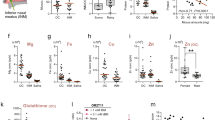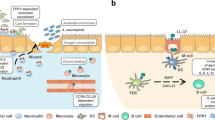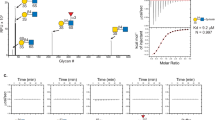Abstract
The classical class I antigens of the major histocompatibility complex (MHC) are cell-surface glycoproteins which were originally discovered because they cause rapid rejection of cells or tissues grafted between unrelated individuals. These molecules are encoded by the K, D and L loci of the mouse MHC (and analogous loci in other species) which show extreme species polymorphism and a large number of alleles1. In an outbreeding population 3.6 x109 unique MHC class I phenotypes can be encoded by the 100 alleles at each of the K and D loci2 and the 6 alleles at the L locus3. This level of polymorphism ensures that the cells and tissues of each unrelated individual are uniquely identified by their class I membrane-bound antigens. Like other membrane bound proteins, these class I molecules are anchored in the lipid bilayer by a hydrophobic domain encoded by exon 5. However, there have been reports of the occurrence of classical class I molecules in true solution in the blood of humans4,5, mice6,7, and rats8. We report here that classical polymorphic class I molecules in normal rats are constitutively excreted in the urine and that untrained rats can distinguish the smell of urine samples taken from normal donors that differ only at the class I MHC locus and therefore excrete different allelomorphs of class I molecules in their urine.
This is a preview of subscription content, access via your institution
Access options
Subscribe to this journal
Receive 51 print issues and online access
$199.00 per year
only $3.90 per issue
Buy this article
- Purchase on Springer Link
- Instant access to full article PDF
Prices may be subject to local taxes which are calculated during checkout
Similar content being viewed by others
References
1. Klein, J. The Natural History of the Histocompatibility Complex (Wiley, New York, 1986). 2. Duncan, W. R., Wakeland, E. K. & Klein, J. Immunogenetics 9, 261–272 (1979). 3. Klein, J. in Histocompatibility Antigens: Structure and Function. Receptors and Recognition, Series B. (eds Parham, P. & Strominger, J.) 221–239 (Chapman and Hall, London, 1982). 4. Van Rood, J. J., Van Leeuwen, A. & Van Santen, M. C. T. Nature 226, 366–367 (1970). 5. Vincent, C. & Revillard, J. P. Transplant Proc. 11, 1301–1302 (1979). 6. Callahan, G. N., Ferrone, S., Allison, J. P. & Reisfeld, R. A. Transplantation 20, 431–433 (1975). 7. Callahan, G. N., Ferrone, S., Penlik, M. D., Reisfeld, R. A. & Klein, J. /. Immun. 117, 1351–1355 (1976). 8. Zimmerman, F. A. el al. Transplant. Proc. 11, 571–577 (1979). 9. Diamond, A. D. et al. Eur. J. Immun. 14, 405–412 (1984). 10. Hart, D. N. J. & Fabre, J. W. Transplant. Proc. 13, 1329–1332 (1981). 11. Roser, B. & Dorsch, S. E. Immunol. Rev. 46, 55–86 (1979). 12. Scatchard, G. Ann. N.Y. Acad. Sci. 51, 660–672 (1949). 13. Ekins, R. P. Br. med. Bull. 30, 3–11 (1974). 14. Sundberg, H., Doving, K., Novikov, S. & Ursin, H. Behavioural and Neural Biology 34, 113–119 (1982). 15. Butcher, G. W. & Howard, J. C. Handbook of Experimental Immunology, 4th edn (ed. Weir, D. M.) 101.1–101.18 (Blackwell, Oxford, 1986). 16. Brown, R. E. & Macdonald, D. W. (eds) Social Odours in Mammals (Oxford University Press, 1985). 17. Brown, R. E. Advances in the Study of Behaviour 10, 103–162 (1979). 18. Beauchamp, G. K., Yamazaki, K. & Boyse, E. A. Sci. Am. 253, 66–72 (1985). 19. Yamazaki, K. et al. J. exp. Med. 144, 1324–1335 (1976). 20. Bruce, H. M. Nature 1284, 105 (1959). 21. Dominic, C. J. /. Reprod. Pert. 8, 266–267 (1964). 22. Yamazaki, K. et al. Science 221, 186–187 (1983). 23. Yamazaki, K. et al. Proc. natn. Acad. Sci. U.S.A. 83, 740–741 (1986). 24. Wysocki, C. J., Wellington, J. L. & Beauchamp, G. K. Science 207, 781–782 (1980). 25. Johns, M. A., Feder, H. H., Komisaruk, B. R. & Mayer, A. D. Nature 272, 446–447 (1978). 26. Yamazaki, K. et al. J. exp. Med. 150, 755–760 (1979). 27. Townsend, A. R. M., Bastin, J., Gould, K. & Brownlee, G. G. Nature 324, 575–577 (1986). 28. Maryanski, J. L., Pola, P., Corradin, G., Jordan, B. R. & Cerottini, J.–C. Nature 324, 578–579 (1986). 29. Bevan, M. J. & Fink, P. J. Immun. Rev. 42, 3–19 (1978). 30. Zinkernagel, R. M. & Doherty, P. C. Adv. Immun. 27, 51–177 (1979). 31. Schwende, F. J., Jorgenson, J. W. & Novotny, M. J. chem. Ecol. 10, 1603–1615 (1984). 32. Kirk, R. E. Experimental Design: Procedures for the Behavioural Sciences (Brooks/Cole, Belmont, California, 1968). 33. Brown, R. E., Singh, P. B. & Roser, B. J. Physiology and Behaviour (Pergamon, Oxford, in the press). 34. Ford, W. L. in Handbook of Experimental Immunology (ed. Weir, D. M.) 23.1–23.22 (Blackwell, Oxford, 1978). 35. Parham, P. J. biol. Chem. 254, 8709–8712 (1979). 36. Laemmli, V. K. Nature 227, 680–685 (1970). 37. Stephenson, S. P. Livingstone, A. M., Butcher, G. W. & Howard, J. C. Transplann Proc. 17, 1844–1846 (1985). 38. Heusser, C., Boseman, M., Nordin, J. H. & Isliker, H. J. Immun. 110, 820–828 (1973).
Author information
Authors and Affiliations
Rights and permissions
About this article
Cite this article
Singh, P., Brown, R. & Roser, B. MHC antigens in urine as olfactory recognition cues. Nature 327, 161–164 (1987). https://doi.org/10.1038/327161a0
Received:
Accepted:
Issue Date:
DOI: https://doi.org/10.1038/327161a0
This article is cited by
-
Mate genetic similarity affects mating behaviour but not maternal investment in mice
Scientific Reports (2023)
-
Alterations of the volatile metabolome in mouse models of Alzheimer’s disease
Scientific Reports (2016)
-
Of volatiles and peptides: in search for MHC-dependent olfactory signals in social communication
Cellular and Molecular Life Sciences (2014)
-
Mouse urinary peptides provide a molecular basis for genotype discrimination by nasal sensory neurons
Nature Communications (2013)
-
Genomic architecture of MHC-linked odorant receptor gene repertoires among 16 vertebrate species
Immunogenetics (2010)
Comments
By submitting a comment you agree to abide by our Terms and Community Guidelines. If you find something abusive or that does not comply with our terms or guidelines please flag it as inappropriate.



